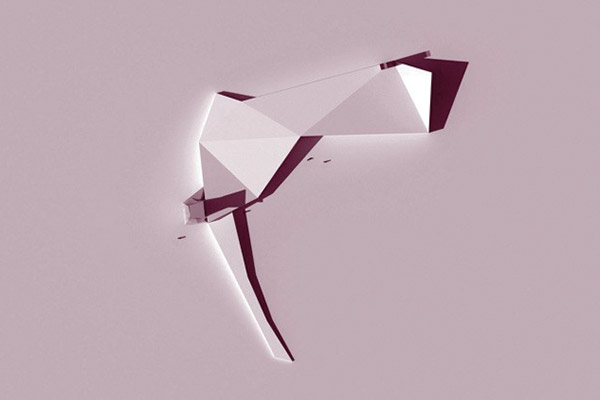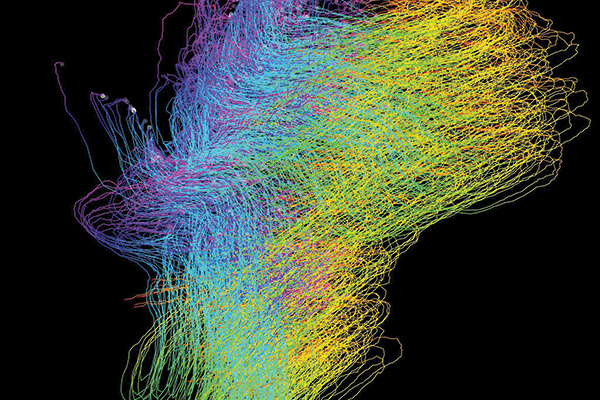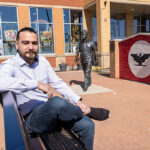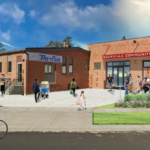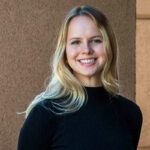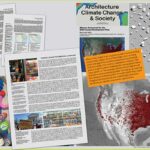The School of Architecture & Urban Planning faculty disseminate their research, scholarship, and design work through grants, articles, competitions, panel sessions, and conference presentations.
After 10 years in the Department of Architecture, Associate Professor Manu Sobti departed UWM for the University of Queensland in Brisbane, Australia.
Professor Sobti’s expertise in non-Western history and global urbanity significantly impacted the School. He engaged a range of students in his research, including those in the doctoral program funded through global grants and undergraduate research assistants funded through the UWM SURF program, travelling with them on life-altering visits to Uzbekistan. Professor Sobti led numerous study abroad trips to India, including the recent Urban Edge Studio —“Rethinking the Urban Edge”—taking students to Delhi, Agra and Chandigarh.
Professor Sobti held numerous fellowships at the University, including the Global Research Fellowship and Center for 21st Century Studies Fellowship, which fostered many interdisciplinary collaborations with faculty across UWM and the world.
He co-coordinated the Buildings-Landscapes-Cultures (BLC) Program in collaboration with the Department of Art History at the University of Wisconsin–Madison, directed a number of student dissertation projects and expanded the impact of the Buildings-Landscapes-Cultures (BLC).
Sobti’s PhD students include Sahar Hosseini, whose research focuses on urban spaces and public institutions in pre-modern Persia and their metamorphosis during the passage to modernity; Kate Malaia, whose research includes the examination of social, spatial and aesthetic transformations of urban environments following the collapse of the Soviet Union; Nader Sayadi whose research covers the bilateral relationship between socio-geographical goods production networks and its interconnected craft landscapes in the eighteenth and nineteenth centuries Middle East; and Leila Saboori, whose research focuses on the history of Middle Eastern cities and the way contemporary built environments have honored past values, tradition, and design principals.
Professor Sobti raised the level of inquiry around topics of global history and theory at the School while seamlessly connecting his studio courses to research and critical thinking. He inspired students and faculty alike to become global citizens. His legacy at the School will be felt for many years to come. We are delighted to have been a part of Professor Sobti’s academic career and wish him the best of luck.
Visiting Architecture Fellow Antonio Furgiuele will be joining the faculty at the Wentworth Institute of Technology in Boston. As the SARUP Research Fellow, Adjunct Assistant Professor Furgiuele researched datascapes for architectural implications. Antonio’s contributions to school culture included leadership on events like Frozen Formfinding, Arch is for the Birds, ArtsBarge, and participating in SUPERjury. He had an enormous impact on the academic life of the School as well, coordinating ARCH 310. A heartfelt thanks to Antonio for all he has shared with us over the past two years.
Urban Planning Professor Sammis White, one of the founding members of the Masters degree program in Urban Planning, retired this May after a long and illustrious career at UWM spanning 44 years. Dr. White focused on issues in public policy, economic development, education, and housing, with specific interests in job creation and education in central cities. White co-founded and for ten years co-edited the leading economic development journal, Economic Development Quarterly. In addition to his role at the school, he had been a faculty member at the UWM School of Continuing Education, most recently serving as Interim Dean and Director of Workforce Development.
Professor White was active in the creation of the Milwaukee 7’s Water Council and the UWM School of Freshwater Sciences. He contributed to the creation of BizStarts Milwaukee and to a better understanding of the many issues impeding the Milwaukee 7’s initiative to bolster the region’s economy. His multiple positions allowed him to undertake research on a variety of urban issues and bring real-life lessons to the classroom. Such activities have contributed to White having won departmental, School, and University teaching awards. White was a central actor in the building of the water technology cluster in southeast Wisconsin and assisted the development of two other industrial clusters in Wisconsin.
We will miss Sam’s presence at the School and thank him for his dedicated efforts on behalf of students and the profession.
Steve Heidt, Assistant Dean and SARUP Business Manager, retired this spring after many years at School of Architecture and Urban Planning and the UWM College of Letters and Sciences Department of Biological Sciences. We wish him good luck in his future endeavors!
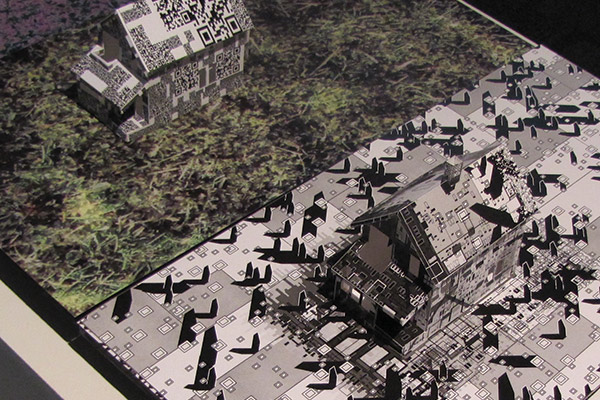
Urban Planning Faculty member Robert Schneider was promoted to Associate Professor with tenure. What a banner year for Bob. Since arriving in the Department of Urban Planning in January 2013, he has published 12 peer-reviewed articles in the sustainable transportation field covering topics such as characteristics of the top 100 cities in the United States for bicycle commuting, features of shopping districts that support walking and public transportation, and innovative methods to count pedestrians and bicyclists. As a national expert in pedestrian and bicycle planning, Bob has quickly become one of the most popular teachers on the faculty, reflecting a growing interest in multimodal transportation throughout the United States and in southeast Wisconsin. Bob uses his research experience to engage in local transportation planning issues. His Wisconsin Pedestrian and Bicycle Crash Analysis, conducted with Joe Stefanich (MArch/MUP 2016), was featured in multiple news stories and led to his recognition as “Advocate of the Year” by the Wisconsin Bicycle Federation. Bob also developed a Bus Rapid Transit (BRT) course along with colleague Lingqian (Ivy) Hu in fall 2015, allowing students to share their vision for stations, dedicated lanes, and system routes with local professionals and members of the public. Congratulations Associate Professor Schneider!
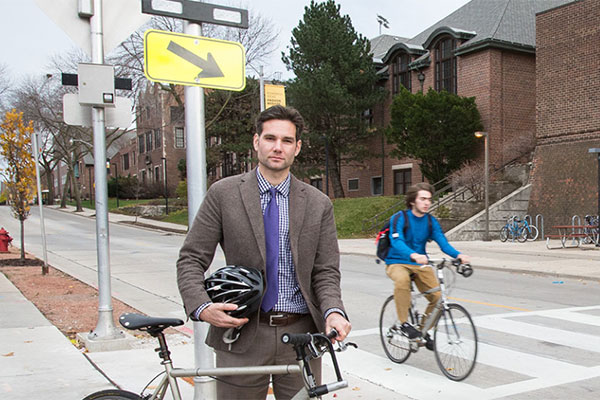
Associate Professor Chris Cornelius (studio;Indigenous) is one of ten architects invited to participate in the inaugural J. Irwin Miller and Xenia S. Miller Prize Competition, which will coincide with the inaugural 2016 symposium for Exhibit Columbus, “Foundations and Futures,” September 30 to October 1, in Columbus, Indiana.
Chris will also participate, as one of the ten, in a gallery exhibition at IUCA+D, September 9–October 7. Through a juried competition the Miller Prize will be awarded to five designers and design teams who will design, build, and install temporary projects in response to one of five sites, each of which is a Columbus icon. Chris’ site will be the First Christian Church, 1942; Saarinen and Saarinen. He will be competing against Howeler + Yoon on the site.
This competition’s name honors the legacy of two of the twentieth century’s greatest patrons of architecture, design, and art, and a family whose visionary commitment to community remains unparalleled.
“Exhibit Columbus will encourage visitors to explore the design legacy of Columbus while re-energizing the community around the potential to realize new designs in Columbus,” said Richard McCoy, director of Landmark Columbus. “This innovative program is a model that talks about the importance of place and community, themes that are nationally relevant.”
